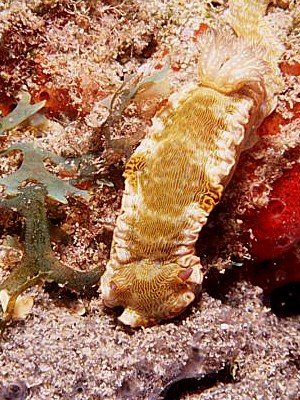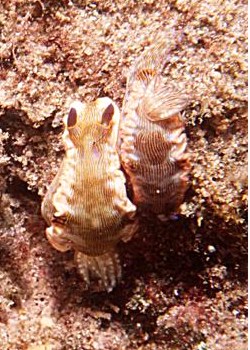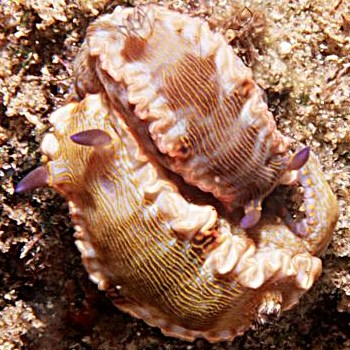Hypselodoris acriba or H. edenticulata?
September 25, 2001
From: Anne DuPont

Note added 31 May 2010: This species has recently been named H. juliae.
Dear Bill,
Here is a follow-up on my earlier photos of an animal which could have been Hypselodoris acriba or H. edenticulata.
On Sunday, September 16, 2001, I was able to dive the site where we have found the earlier specimen of Hypselodoris sp. in 12 feet of water off Boca Raton, Florida.
We were very fortunate to find 4! One small pair together mating? [Lower photos]. One larger one close by with its head in a hole. nd one feeding(?) on the purple sponge [Upper right photo; see also separate message]. This is the same sponge that I was telling you about from the first sighting. Hopefully these 4 photographs will give you more insight into identifying it.
To give you some background information on our finds, shortly after entering the water my dive buddy found the pair together (mating?) along side the larger one with its head in the hole. They were together for a short while, and then came apart, and one crawled off. About 15 feet down the little ledge, we found the 4th one who was eating on the blue sponge.
After photographing it eating, we went to other parts of the reef looking for another nudibranch. After about 80 minutes, we came back to the 4 nudibranchs. The pair were together again, (mating?) and the big one still had its hole in the reef, and the 4th one was still eating away!
Best regards,
Anne
Delray Beach, Florida, USA
akdupont@bellsouth.net


Thanks Anne,
For these wonderful photos. What a delight it must have been to go back to the same spot and find these animals again. Firstly about their biology. I am pretty sure they are mating - or at least seriously considering it! And I am also pretty sure they are feeding. To have their heads stuck like this for 80 minutes or so suggests they were doing something, and the chance of finding them with the same sponge as last time, just by coincidence, doesn't seem very high. One way to check if any of these dorids are feeding is the gently push their head aside. While you won't see them actually munching away you will almost certainly see the inflated sac-like oral tube which everts out of the mouth to bring the teeth in contact with the food. If that is visible its a good sign that feeding has been taking place.
Concerning its identity. I can really only repeat what I said in reply to your earlier message. It doesn't seem to be the H. edenticulata form of H. picta, or H. acriba or H. ruthae. Two characteristic features of your species seem to be the dark patch at the edge of the mantle about half way down each side, and the white spots on the gills. if you look at Dave Behren's photo of H. acriba you can see a similar dark patch at the mantle edge. This is not mentioned in the original description of the species but is clear in this photo. One of the major differences between the two is that in H. acriba the yellow lines on the mantle form a reticulate network while in your animal they form a series of longitudinal lines. However if you look closely at the head of the animal in your upper right photo you can see the lines form a reticulate pattern.
I guess we will have to wait until more is known about these animals, perhaps they are closely related but distinct species, perhaps they are extreme forms of one species. If it is a distinct species, it would appear to be unnamed.
Best wishes,
Bill Rudman.
Related messages
-
Hypselodoris juliae from Brazil [2]
From: Peter Wirtz, June 3, 2010 -
Hypselodoris juliae from Brazil [1]
From: Vinicius Padula, May 31, 2010 -
Hypselodoris sp. 4 - Post Mating
From: Linda Ianniello, May 16, 2003 -
Hypselodoris sp. 4 eggs
From: Linda Ianniello, September 27, 2002 -
Food of Hypselodoris sp. 4
From: Anne DuPont, October 6, 2001 -
Re: Hypselodoris sp. 4 from Florida
From: Linda Ianniello , October 5, 2001 -
Food of Hypselodoris sp. 4
From: Anne Dupont, September 25, 2001 -
Hypselodoris acriba or H. edenticulata
From: Anne DuPont, August 21, 2001
